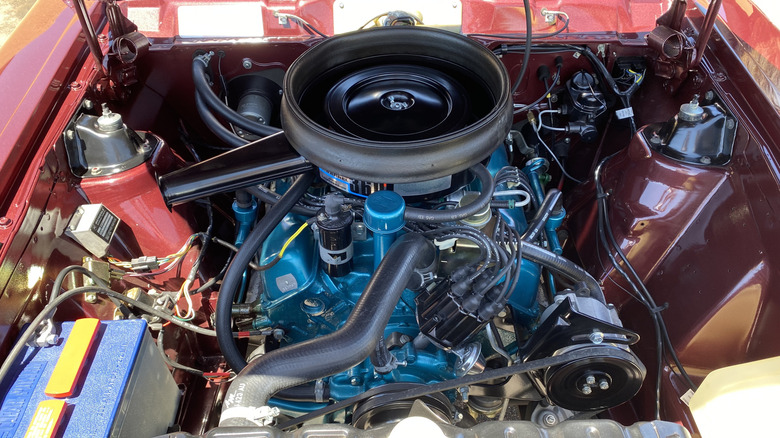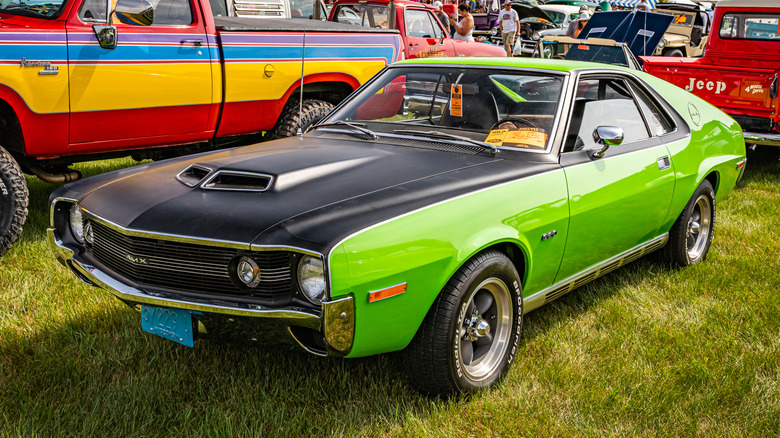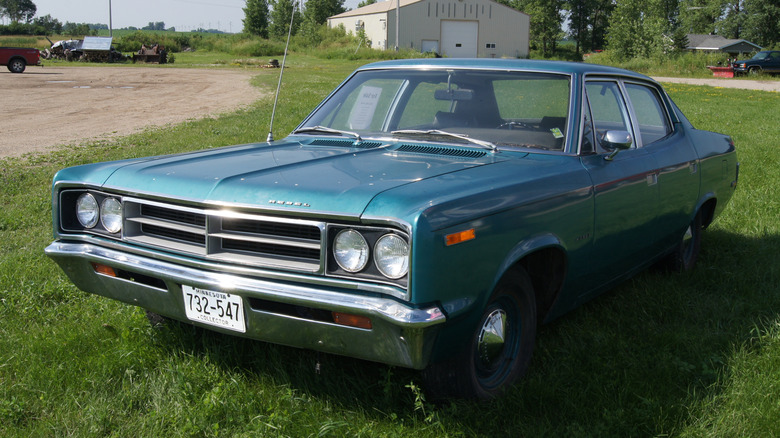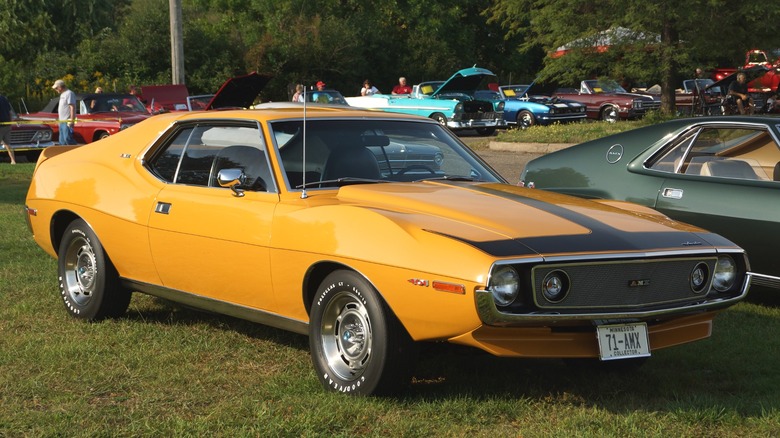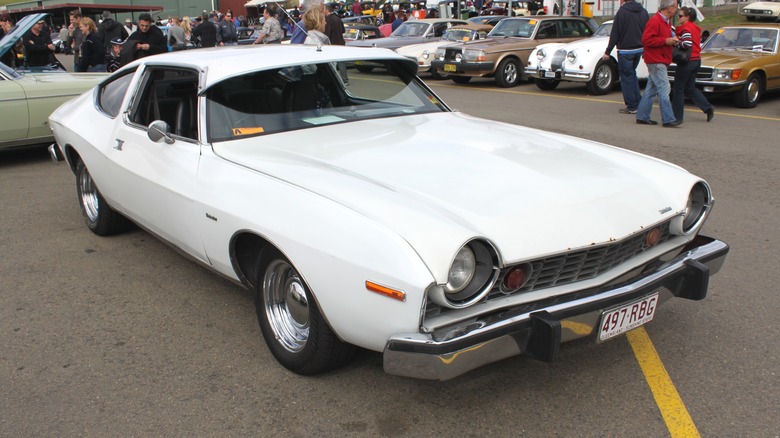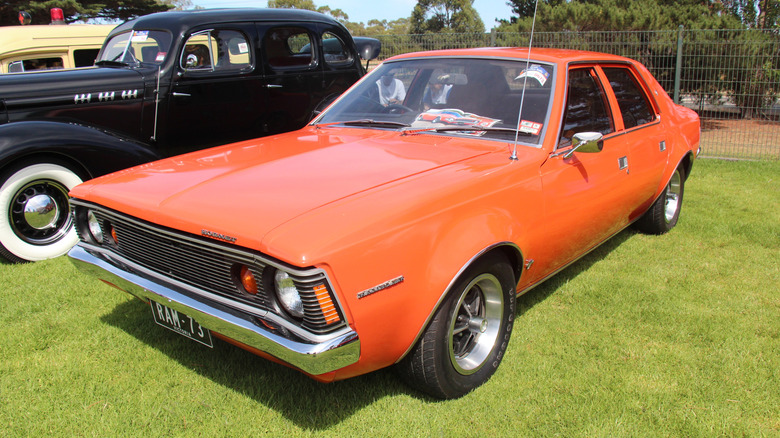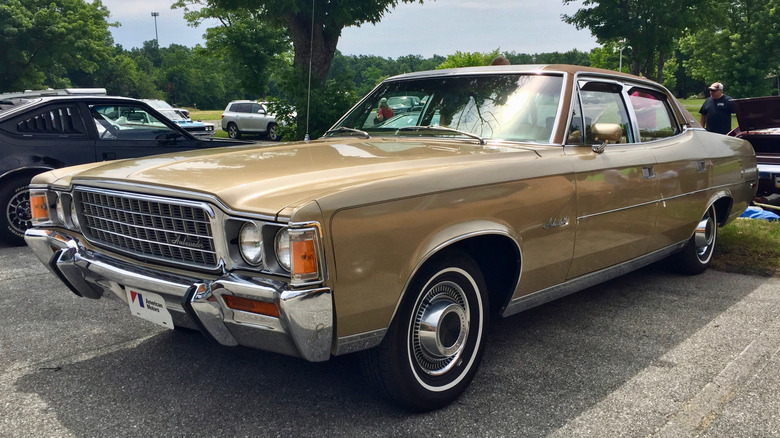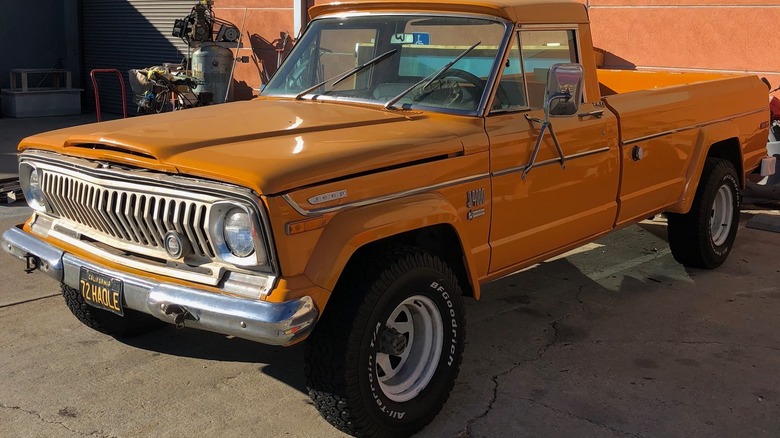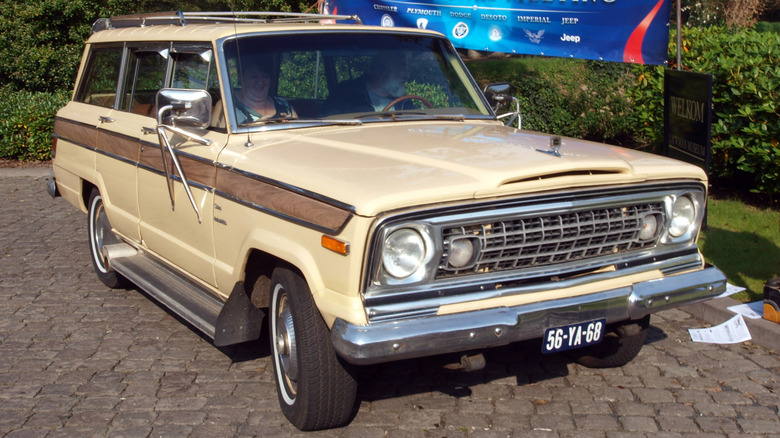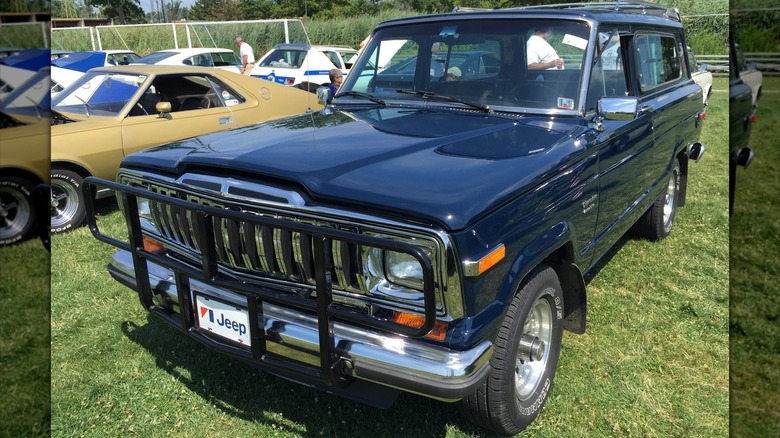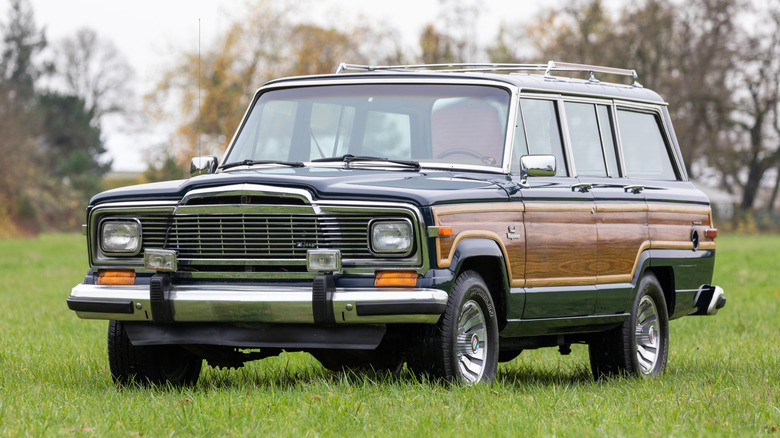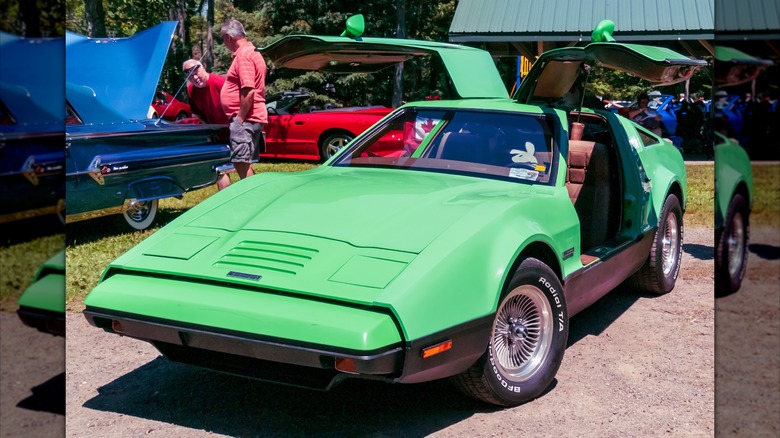Every Vehicle Powered By The AMC 360 V8 Engine
The American Motors Corporation (AMC) is likely best remembered as the plucky underdog competitor to the Big Three in the late 1960s and 1970s, with cars like the Hornet, Javelin, Matador, and unfairly maligned Gremlin existing as interesting and affordable alternatives to the usual fare out of Detroit. This isn't to say that AMC was all about making budget-friendly cars, though: the AMX was a bonafide muscle car hero, and the company's ownership of Jeep birthed the Jeep Cherokee, which modern enthusiasts regard quite highly.
At the heart of AMC's offerings were its engines. The company built six- and eight-cylinder engines, from a 258 cubic inch inline-six to a 401 cubic inch V8 that powered vehicles like the AMC Javelin and Jeep Wagoneer in the 1970s. Between those two sat a few 300 cubic inch engines, the most common of which is the 360 cubic inch V8 that replaced a 343 cubic inch V8 in 1970 and would go on to power a range of AMC and Jeep vehicles over the next two decades.
Interestingly, the official Jeep website mentions that AMC started offering Jeep CJs with the 360 V8 in 1973, but we can't find any evidence of that ever; contemporary catalogs indicate that the CJs only ever came with the 304 cubic inch V8 at most. So, we decided to leave the Jeep CJ off this list. With that out of the way, let's look at all the cars powered by this engine.
[Image by CZmarlin via Wikimedia Commons | Cropped and scaled | CC BY-SA 4.0]
AMC AMX (1970)
The AMC AMX was the company's attempt at a flagship muscle car, debuting as a mid-year model in February 1968. AMC pitched the AMX — which stood for American Motors Experimental — as a rival for the Chevrolet Corvette, which was the only other American-made two-seater sports car available at the time. AMC had an ace up its sleeve, though, and planned to sell the AMX for around $1,000 less than the Corvette (that'd be around $9,000 today, when adjusted for inflation).
Befitting its performance aspirations, AMC initially offered the AMX with one of three V8s under the hood. The standard engine was a 225-hp 290 cubic inch V8, but buyers could also opt for a 280-hp 343 cubic inch V8 or a 315-hp 390 cubic inch V8. The latter two engines were also available with the "Go" Package, which offered several upgrades including a Twin-Grip differential, upgraded cooling, and improved handling.
For 1970, AMC revamped the AMX's engine options, ditching the 290 cubic inch and 343 cubic inch V8s. In their place was a new AMC 360 V8 which made 290 hp and 395 lb-ft of torque with a four-barrel carb. Unfortunately, the new engine didn't help sales much: Only 4,116 AMXs left the factory in 1970, and AMC discontinued the model after that. The company revived the AMX badge for a trim level on the second-generation Javelin starting in 1971 but it wasn't quite the same — the classic two-door AMX muscle car is likely the model enthusiasts remember most fondly.
AMC Rebel (1970)
AMC's Rebel had its roots in 1957, when the company released the Rambler Rebel. Sometimes considered one of the first-ever muscle cars, the Rambler Rebel packed a 327 cubic inch, 255 hp V8 into a mid-sized four-door body. The Rambler Rebel didn't sell well, and AMC dropped it soon after, with the Rebel name lying dormant until AMC resurrected it as a trim level for the 1966 Rambler Classic.
The Rebel's resurrection continued in 1967 when AMC decided to use the name for all of its intermediate cars. Available in two-door, four-door, convertible, and wagon body shapes, the 1967 Rebel sported a single-barrel 232 cubic inch inline-six engine by default, with two- or four-barrel 290 cubic inch and 343 cubic inch V8s also available, the latter available with an optional dual exhaust by 1969 — albeit without an equivalent to the Javelin and AMX's "Go" Package.
At least, not until 1970. The new decade saw the 360 cubic inch V8 taking the 343 cubic inch V8's place, with numbers climbing to 295 hp and 395 lb-ft of torque. However, the biggest change was the "Machine" package for hardtop Rebels. The Rebel Machine received functional upgrades such as a 340-hp 390 cubic inch V8, front disc brakes, and improved suspension, as well as visual — and gimmicky — changes such as a red-white-and-blue paint job and a hood-mounted tachometer. 1970 proved to be the final year of the Rebel, though: AMC replaced it with the Matador in 1971.
[Image by Greg Gjerdingen via Wikimedia Commons | Cropped and scaled | CC BY 2.0]
AMC Javelin (1970 - 1974)
The Javelin was AMC's bid for the youth market, debuting in 1968 as a Ford Mustang competitor with a two-door hardtop as the only body style. Available in standard and more premium SST trim levels, the 1968 Javelin came with a 145-hp inline six as standard, with 290 cubic inch and 343 cubic inch V8s as standard. The latter engine, in its 280-hp, four-barrel guise, was only available with the Javelin's "Go" package, which added dual exhausts, disc brakes, wider tires, rally stripes, and a handling package.
As with AMC's other 343-equipped cars of the 1960s, the Javelin switched to the 290-hp, 395 lb-ft 360 cubic inch V8 for 1970. But unlike the original AMX or Rebel, the Javelin continued into the next decade. The second-generation Javelin debuted in 1971 with a radically new — and supposedly Italian-inspired — design and the 360 cubic inch in two- and four-barrel configuration. On-paper numbers had dropped slightly compared to 1970, though: the four-barrel 360, for example, now made 285 hp and 390 lb-ft.
AMC retained the 360 cubic inch V8 as an optional engine in the Javelin and Javelin AMX throughout the second-generation Javelin's run, which ended in 1974. By the end, the 360 cubic inch V8's power numbers had dropped to 175 and 220 hp — the latter with a four-barrel carburetor and dual exhausts — due to the shift from gross to net horsepower measurements, although a slight drop in compression to 8.25:1 probably didn't help either.
[Image by Greg Gjerdingen via Wikimedia Commons | Cropped and scaled | CC BY 2.0]
AMC Matador (1971 - 1978)
So far, our list of 360 V8-powered AMCs has been a tale of brief production runs, with even the comparatively long-lived Javelin only sporting the 290-hp engine for four years. That's not a charge you could level at the AMC Matador, which AMC built for seven years across two generations, with the 360 cubic inch V8 available throughout that run.
AMC introduced the Matador to replace the Rebel in 1971, although the new car retained the 1970 Rebel's engine options. AMC also offered a one-year-only Machine Go package for the 1971 Matador, available with the 360 cubic inch V8 or the then-new 401 cubic inch V8. This $373 — around $2,900 in 2024 — package added a four-barrel carb and dual exhausts to the 360, alongside a new handling package, front disc brakes, Goodyear Polyglas tires, and 15-inch steel wheels. AMC dropped the package for 1972 but kept the Matador going with few major changes for the next couple of years.
The biggest change came when AMC debuted the Matador Coupe in 1974, although engine options remained the same beyond a drop in power numbers due to new net horsepower measurements. The four-barrel 360 cubic inch V8 now made 195 net hp, for example, which climbed to 220 hp if specced with dual exhausts. AMC continued offering the 360 in the Matador until 1978 when dwindling sales led AMC to discontinue the model.
[Image by Jeremy via Wikimedia Commons | Cropped and scaled | CC BY 2.0]
AMC Hornet (1971 - 1974)
The 360 cubic inch V8 tended to be a short-lived option in AMC's passenger cars, and the Hornet was no exception. The Hornet debuted in 1970 in two- and four-door styles and a tame set of engine options: single- and dual-barrel carb versions of the 258 inline-six and the two-barrel 304 cubic inch V8.
AMC introduced a station wagon body called the Sportabout in 1971 alongside the SC 360, which, as the name suggested, had the 245-hp, two-barrel 360 cubic inch V8 under the hood — with the full-power, 285-hp four-barrel version also available for buyers willing to spend extra. Like on the Javelin, AMC also offered a "Go" Package for the SC 360, which pushed owners to the four-barrel 360 and added the standard upgrades: dual exhaust, a handling package, Polyglas tires, and ram-air intake.
1972 saw AMC drop the basic and SC 360 Hornets, with all three body styles now only available in SST trim. The 360 cubic inch V8 stayed, albeit only with a two-barrel carburetor — and, like on other post-1971 AMCs, with new net power ratings of 175 hp and 285 lb-ft of torque. AMC kept tweaking the Hornet formula and introduced the Hornet Hatchback in 1973, although that was the last big change. The 360 cubic inch V8 trundled on for another year after that before AMC stopped offering it in the Hornet from 1975.
[Image by Cars Down Under via Flickr | Cropped and scaled | CC BY 2.0]
AMC Ambassador (1970 - 1974)
AMC's Ambassador was in a way the crown jewel of its passenger car lineup, an example of the company's ability to compete with the Big Three on the spec sheet as well as in price. The 1971 Ambassador sported air conditioning and an automatic transmission as standard, a combination that not even Chrysler offered on its contemporary luxury vehicles.
The seventh-gen Ambassador debuted in 1969 with the 232 cubic inch inline-six or one of three V8s — the 290, 343, and 390 cubic inch engines — under the hood. AMC quickly replaced the 343 with the 360 cubic inch V8 once it began building the larger engine in 1970, and offered it, in either a two- or four-barrel setup, as an option on all three Ambassador trim levels. AMC revised the Ambassador's engine options slightly in 1972 by dropping the inline-six, making the Ambassador an exclusively V8-powered model for the rest of its run.
Unlike some of AMC's smaller cars, Ambassador owners didn't have to settle for the two-barrel 360 V8: AMC continued to offer two- and four-barrel carburetors on the Ambassador, with dual exhausts an optional extra for the four-barrel 360 cubic inch V8 or 401 cubic inch V8. The exhausts weren't just for show, either; the four-barrel 360 climbed to 225 net hp with the exhausts, compared to 195 hp without. AMC offered the 360 and 401 cubic inch V8s on the Ambassador through to 1974, after which AMC discontinued the nameplate.
Jeep J-series trucks (1971 - 1987)
Jeep's J-10 and J-20 trucks started their lives in the Kaiser-Jeep era of the 1960s as the Gladiator pickups. The Gladiators — vintage trucks still worth buying even today — were available in 120- and 126-inch wheelbase variants and came with the 140-hp Jeep Tornado six-cylinder as standard for the first few years before AMC introduced a 327 cubic inch engine to the Gladiators in 1965.
AMC dropped the Gladiator name in 1971, renaming the trucks as the J2000 and the J4000 and introducing new engines — including the 360 cubic inch V8, which was standard on the higher G.V.W. J400 trucks and optional on the J2000. AMC continued with the J2000 and J4000 naming for a few more years before renaming the trucks again, to the J-10 and J-20, in 1974 — also the year it introduced the 401 cubic inch V8 to the J-series engine bay.
The 360 cubic inch V8 continued as the mid-range engine option for the J-series trucks for the next few years. The J-20 had a two-barrel 360 as standard, but both trucks were available with a four-barrel 360 if desired. AMC dropped the 401 and four-barrel 360 after 1978, leaving the 258 six and two-barrel 360 as the only available engines — a state of affairs that continued until 1987 when Chrysler acquired Jeep (by buying AMC outright). The new owners discontinued the J-10 and J-20, marking the end of trucks like the oh-so-stylish J-10 Head Honcho.
[Image by Accord14 via Wikimedia Commons | Cropped and scaled | CC BY-SA 4.0]
Jeep Wagoneer (1972 - 1983)
The Jeep Wagoneer was Jeep's full-size luxury offering, debuting in 1963 during Kaiser's ownership. Like the Gladiator trucks, the Wagoneer initially came equipped with Jeep's Tornado engine, which made a healthy 140 hp and 210 lb-ft of torque, with an optional four-wheel-drive system available for serious off-roading.
A selection of AMC and Kaiser engines featured in the Wagoneer throughout the rest of the decade before AMC's takeover of Jeep triggered a transition to a whole new generation of AMC powerplants. AMC introduced its 258 cubic inch inline-six and two V8s, the 304- and 360 cubic inch V8 engines, in 1971. The latter replaced a 350 cubic inch Buick V8 that Kaiser had used around the turn of the decade, although AMC did make a few Buick-powered 1414x Wagoneers to finish up leftover stock.
AMC dropped the 304 a couple of years later, making the 360 cubic inch V8 — available with a two- or four-barrel carburetor — the sole eight-cylinder engine available to Wagoneer buyers for 1973. The next year, the company dropped the 258 cubic inch V8 and introduced the 401 cubic inch V8 in 1974, pushing the Wagoneer upmarket and targeting more affluent buyers. However, the 401 only lasted four years, and the two-barrel 360 V8 ended up as the only engine available in the Wagoneer by the end of the decade. Jeep reintroduced the 258 cubic inch inline-six in 1980, and the two engines remained in the Wagoneer until Jeep released an all-new Wagoneer in 1984.
Jeep Cherokee (1974 - 1983)
AMC introduced the Cherokee in 1974 to fill the gap left by the Wagoneer, which the company had pushed into a more premium price bracket. So, instead of the family-oriented luxury and four doors of the mid-'70s Wagoneer, the 1974 Cherokee was a sporty, two-door take on the same body shape, sold at an appreciably lower price — $340 cheaper, or just under $2,200 in 2024 — than the previous year's Wagoneer.
There is a valid question about whether AMC's decision to hike the Wagoneer's price and compensate for it with a cheaper, less-equipped model was the right one, but that's not one for us right now. Poor decision or not, AMC at least retained the bigger Wagoneer's engine options for the Cherokee: the base engine was the 110-hp 258 cubic inch inline-six, while two- and four-barrel versions of the 360 cubic inch V8 were also available, the latter making its usual 195 hp. AMC also offered the 401 cubic inch V8 in the Cherokee.
This four-engine menu didn't last long, though, and by 1979, the only two engines available to prospective Cherokee buyers were the inline six and a two-barrel 360. AMC maintained these engine options for the rest of the Cherokee's initial run, which ended in 1983. AMC introduced the classic XJ-platform Cherokee in 1984, which came with a new range of engines: a 2.5-liter four-cylinder, a 2.8-liter V6, and a 2.1-liter turbo-diesel.
[Image by CZmarlin via Wikimedia Commons | Cropped and scaled | CC BY-SA 4.0]
Jeep Grand Wagoneer (1984 - 1991)
Jeep's decision to move the Cherokee and Wagoneer to the all-new — and smaller — XJ platform in 1984 could have spelled the end for the venerable SJ Wagoneer. But AMC kept it around, renaming it the Grand Wagoneer and offering it with a wide range of luxury options, including a power tailgate window, cruise control, and air conditioning.
The standard engine in the new-but-old Grand Wagoneer was a 4.2-liter six-cylinder, with the 5.9-liter — 360 cubic inch — V8 also available. The V8 made 140 net hp and 280 lb-ft of torque, a healthy improvement over the inline-six's 110 hp and 210 lb-ft. AMC paired both engines with a three-speed transmission and Selec-Trac four-wheel-drive, and the total package made the Grand Wagoneer one of the best Jeeps ever designed.
Things changed slightly for the 1987 model year, and not because Chrysler purchased AMC. Potential buyers who perused Jeep catalogs that year would notice that the old inline-six was gone, with the 360 cubic inch V8 now the only engine available in the Grand Wagoneer. Beyond ditching the six-cylinder, Chrysler didn't mess with the Grand Wagoneer much; it continued building the truck with few significant changes until 1991, making the Grand Wagoneer one of the last carbureted vehicles ever sold in North America. Stellantis-owned Jeep resurrected the Grand Wagoneer nameplate in 2021, and models like the 2023 Grand Wagoneer L continue the original's luxury-minded heritage, just with a lot more gizmos.
Bricklin SV-1 (1974)
The Bricklin SV-1 is one of those quirky, off-the-wall cars that could only have emerged in the 1970s. One of the coolest cars to ever come with gullwing doors, the SV-1 was the brainchild of entrepreneur Malcolm Bricklin, who wanted to design a modern, safety-compliant car — SV-1 was an abbreviation of Safety Vehicle One — that could compete with high-performance offerings like the Chevrolet Corvette.
To that end, the wedge-shaped SV-1 launched with AMC's 220-hp, 315 lb-ft 360 cubic inch V8 under the hood in 1974, which buyers could pair with a four-speed manual or three-speed automatic. Unfortunately for Bricklin and his major investors, the New Brunswick government, the initial SV-1s were riddled with enough problems to render them unfit for sale — a portent of things to come.
Bricklin swapped the AMC 360 for Ford's 175-hp 351 in 1975, but that didn't help much. Not only were the cars riddled with issues, but the 1975 SV-1's price had ballooned to nearly $10,000. That made faults such as an uncomfortable interior and poor material quality much harder to live with. Unsurprisingly, the SV-1 sold incredibly poorly and, by 1976, had put Bricklin and his investors into debt. Bricklin and his companies ended up owing about $70 million, while the New Brunswick government was said to have been out of pocket for around $23 million — all in 1976 money!
